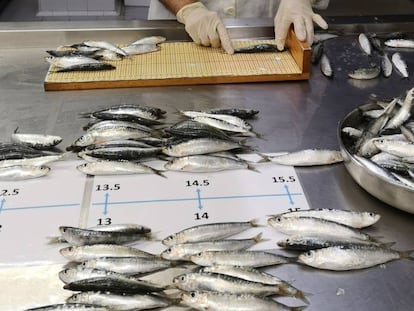Spanish developer of biodegradable battery: ‘Electronic devices will be the next wave of waste’
Award-winning scientist Neus Sabaté talks to EL PAÍS about her development of paper batteries for single-use applications such as pregnancy tests

Award-winning Spanish scientist Neus Sabaté, 46, began studying physics out of sheer curiosity, but soon turned to applied sciences. “I started out asking myself a lot of why-questions and ended up dedicating myself to how,” she explains. A professor at the Institute of Microelectronics in Barcelona, her greatest achievement has been the development of biodegradable paper batteries for single-use devices, which are activated when they come into contact with whatever liquid is being analyzed, such as saliva. But besides her work as a researcher, she is also something of an entrepreneur, founding the company Fuelium in 2015, where these batteries can be purchased.
In spite of this venture, Sabaté considers herself a scientist first and foremost. She has received numerous awards and grants, such as the Consolidator Grant from the European Research Council (ERC) and the 2020 Physics, Technology and Innovation Award, which was presented to her in December by the Spanish Royal Society of Physics and the BBVA Foundation, with the jury highlighting her creativity in the field of biodegradable batteries.
Along with fellow researcher Juan Pablo Esquivel, Sabaté spent years studying batteries and energy sources before deciding to focus on portable devices. The decision was triggered by a digital pregnancy test she took which contained a button cell battery. Both she and Esquivel questioned the wisdom of using a button cell for a single-use device, realizing that only a fraction of the energy it contained would be used. That led to the proposal of using urine or other biological fluids to generate energy, “setting aside the silicon, glass and substrates we’re currently working with, in favor of paper. It makes perfect sense that the same energy source is integrated into the paper,” she points out. According to Sabaté, fundamentally, it would be a case of reversing the usual process of adapting the electronics to these energy sources: in the new scenario, the battery would be adapted and tailored to the application it powers.
“What we are doing with these batteries is deconstructing,” she explains. “Based on our knowledge of the chemical reactions available, we looked for the most benign ones and integrated some very benign reaction electrodes into a paper format. So, the fluid that passes through the paper acts as the electrolyte. For a battery to have this electrolyte, it simply has to have a conducive liquid with salts; biological fluids are perfect because they are salty,” she adds. The main application for these batteries is in the field of diagnostics, such as pregnancy, drugs and infectious disease tests.
The researchers have also raised the possibility of using the technology for molecular tests, as in the tests used during the coronavirus pandemic. But, currently, the diagnostic issue requires a lot of regulation which is why the first market for their batteries is the cosmetic sector, as Sabaté explains. However, she hopes to reach the diagnostic market within a few years.
Before the pandemic struck, Sabaté was already in talks with the Bill and Melinda Gates Foundation to use these batteries in developing countries, especially with regard to infectious diseases, because that is where “they really have the greatest social impact.” But that doesn’t mean they can’t be very beneficial in the West: “We also have a problem with electronic devices here,” she says. “They are going to generate the next wave of waste. Everyone is thinking plastic, but the next conundrum is what we do about the frequency with which we renew our electronic devices and whether we should be allowed to make single-use devices that have so many electronics in their batteries.”
Other applications
Besides the development of single-use biodegradable batteries, Sabaté and her team have succeeded in turning a version of these batteries into a sweat sensor. This is a product in itself and will be marketed by a new company she is setting up. The patches are designed to detect cystic fibrosis in infants and dehydration in runners. They have already been tested in the largest pediatric hospital in Barcelona with results that Sabaté describes as “extremely good.”
As for the obstacles she has overcome, Sabaté speaks of the difficulty of being a scientist in Spain due to the lack of resources. She also says that “there are certain bottlenecks” in the system, resulting in a loss of talent. “I think it is urgent for the political classes to see that industry can be generated through research and that this is what should be promoted in applied science,” she says.
Tu suscripción se está usando en otro dispositivo
¿Quieres añadir otro usuario a tu suscripción?
Si continúas leyendo en este dispositivo, no se podrá leer en el otro.
FlechaTu suscripción se está usando en otro dispositivo y solo puedes acceder a EL PAÍS desde un dispositivo a la vez.
Si quieres compartir tu cuenta, cambia tu suscripción a la modalidad Premium, así podrás añadir otro usuario. Cada uno accederá con su propia cuenta de email, lo que os permitirá personalizar vuestra experiencia en EL PAÍS.
¿Tienes una suscripción de empresa? Accede aquí para contratar más cuentas.
En el caso de no saber quién está usando tu cuenta, te recomendamos cambiar tu contraseña aquí.
Si decides continuar compartiendo tu cuenta, este mensaje se mostrará en tu dispositivo y en el de la otra persona que está usando tu cuenta de forma indefinida, afectando a tu experiencia de lectura. Puedes consultar aquí los términos y condiciones de la suscripción digital.











































